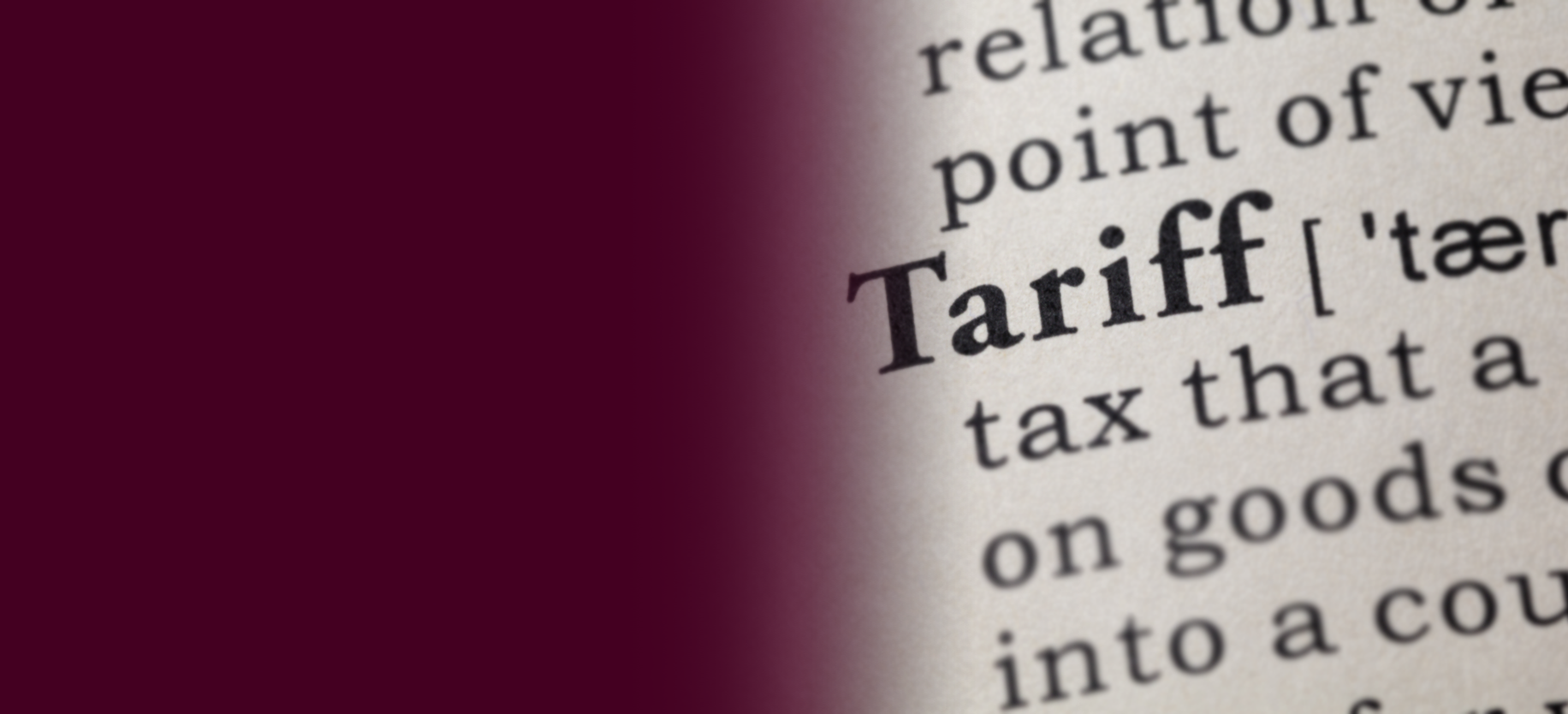With Donald Trump’s re-election to the White House, tariffs are back in the spotlight. Beyond the fog of speculation, social media posts, and market uncertainty, we explore this complex topic through Burgundy’s bottom-up approach.
KEY POINTS
- Trump’s tariffs are not coming out of left field.
- Some companies will benefit, while others may face challenges due to stretched consumer wallets.
- We manage potential risks by monitoring our exposure, staying diversified, and investing in companies with strong management teams.
Tariffs are dominating today’s headlines as Donald Trump continues to raise the stakes. Over the past week, the President-elect has taken to Truth Social to voice his potential measures, including a 25% tariff on all imports from Canada and Mexico. Trump’s other proposals include implementing across-the-board tariffs of 10-20% on all imports into the U.S. and tariffs of upwards of 60% on all Chinese imports. As more countries are brought into the fold and his list of targets grows, the situation is evolving rapidly. When Trump returns to the White House in January, these actions are expected to be among the first initiatives of the new administration.
As media coverage oscillates between downplaying the proposed changes and sounding alarm bells around economic fallout, higher consumer prices, and the threat of trade wars, one thing is certain—the global ripple effects are anything but simple. At Burgundy, we are researchers and long-term thinkers—not soothsayers. While the future of these proposed tariffs is uncertain, we want to take this opportunity to highlight their potential impacts and outline how our investment process helps us navigate these uncertain periods.
Second Verse, Not Necessarily the Same as the First
Since Trump first took office in 2017, the world has experienced profound changes, including a global pandemic, inflation, higher interest rates, and geopolitical conflicts in Europe and the Middle East. As the President-elect looks toward his second term, aggressive tariff policies are central to his approach to tackling the ongoing economic and geopolitical challenges.
In October, during an interview at the Economic Club of Chicago, Trump called the word tariff, “the most beautiful word in the dictionary,” and his “favorite word.” Trump’s plans include using tariffs to raise government revenue, reduce the U.S. trade deficit, revitalize the struggling manufacturing sector, and enhance border security. Tariffs were also a prominent feature of his first term, yet they ended up being largely ineffective in reversing the U.S. trade deficit and manufacturing output. This raises an important question: What might he do differently this time? Negotiation tactic or not, we appreciate that these tariff policies warrant serious consideration.
Many companies have been preparing and adapting to a changing environment since Trump’s first term and the global pandemic, taking steps to reassess their production strategies and build more robust supply chains. With Canada and Mexico now in the mix, and tariffs extending more broadly to China and beyond, we could see major disruptions to global supply chains as companies look to relocate their manufacturing and distribution to be closer to the U.S. consumer. These challenges will be easier for some businesses to manage than others.
The Impact
For many of you, the U.S. equity market represents a significant portion of your portfolio. The market rallied following Trump’s win, suggesting the investing public seems to look favourably on a Trump agenda. Looking ahead, domestically focused small-cap companies are poised to benefit from expected favourable tax and regulatory policies while being less exposed to global supply-chain disruptions. Conversely, larger companies that rely heavily on low-cost imports may face increased risks as tariffs on goods from countries like China drive up costs.
With around 75% of Canada’s exports going to the U.S., the prospect of sizable tariffs is daunting.1 While the automotive and energy sectors are likely to be most affected by potential tariffs, many other exporting industries, including farming, could also face significant impacts. Whether you are a small business, a dairy farmer, an automotive worker, or an average consumer, the implications of new U.S. policies could be significant. The Canadian government must take swift and decisive action to secure a favourable outcome for our nation.
Managing Risk
In light of current tariff talks, we think there are three ways to manage this potential risk in your portfolio: monitoring exposure, having diversified portfolios, and investing in companies with strong management teams.
1. MONITORING EXPOSURE
At Burgundy, we look to invest in companies that we consider to be of good quality. One of the quality characteristics we look for is pricing power—the ability to pass increased costs, such as tariffs, on to customers. However, mitigating cost pressures is often complex and can take time. Since the pandemic, high inflation has strained consumer budgets, so further price increases may prove more difficult this time around. Time will tell.
Lacking investments in the industries most affected by tariffs is an obvious way our portfolios are somewhat protected. Our current investments in Canada have little-to-no exposure to industries like automotive and energy, those most likely to be impacted. As a result, your portfolio is relatively insulated from these immediate risks.
2. A DIVERSIFIED INVESTMENT STRATEGY
While some countries may stand to gain, others will find themselves directly impacted by new U.S. policies. Global companies covet access to the U.S. market, but reaching American consumers may come at a higher price. But remember, no single country—including the United States—holds a monopoly on quality companies. By diversifying across geographies, we can better position you to weather potential changes. For many of you, we think our Partners’ Global strategy, Burgundy’s model equity portfolio for private clients, achieves exactly that.
3. STRONG MANAGEMENT TEAMS
At Burgundy, we view companies as living organisms, with those that can adapt to their evolving environments being the ones that succeed. In a landscape marked by potential tariffs and shifts in the global supply chain, a company’s success may depend on its ability to navigate these complexities. Adaptability begins with strong leadership, which is why we prioritize companies with capable management teams as part of our quality criteria. Another benefit of these companies is that they tend to be more transparent and offer deeper insights into their process. Our Investment Team has already begun engaging in frank and open discussions with their companies about the potential impact of the new U.S. administration’s policies, ensuring we stay informed and ready. As long-term investors, we benefit from the established relationships we’ve built with many of our portfolio companies over the years. Partnering with strong management teams is always an important part of our process, but it becomes particularly critical when the ability to adapt and thrive is tested.
Final Thoughts
There is little doubt that Trump and his incoming administration are serious about addressing weaknesses in U.S. trade and manufacturing, making it a central policy focus. However, political rhetoric does not always translate into actionable policy, and until specific measures are implemented, a significant level of uncertainty remains. If Trump’s tariffs are being used as a negotiation tactic, agreements may be met between the U.S. and the affected countries, potentially leading to them being scaled back. In the meantime, these policy changes could bring some uncertainty and short-term market volatility. Regardless of the outcome, it’s worth noting that many companies have already been preparing for such scenarios and are taking these demands seriously.
At Burgundy, we build our portfolios one company at a time, with no broad strokes, continuously evaluating our portfolio companies to ensure both quality and value exist. Events like these are a double-edged sword, with risk and opportunity on either side of the blade. We will continue to take advantage where we can, looking out for companies that may be unjustly sold off and seeking to upgrade our portfolios’ profile. As long-term investors, our role is to look beyond the immediate noise, identifying resilience and growth potential during times of change—all to preserve and grow your capital.
Subscribe to Views & Insights
- Statistics Canada. (2023). International Trade Reporter.
This post is presented for illustrative and discussion purposes only. It is not intended to provide investment advice and does not consider unique objectives, constraints or financial needs. Under no circumstances does this post suggest that you should time the market in any way or make investment decisions based on the content. Select securities may be used as examples to illustrate Burgundy’s investment philosophy. Burgundy funds or portfolios may or may not hold such securities for the whole demonstrated period. Investors are advised that their investments are not guaranteed, their values change frequently and past performance may not be repeated. This post is not intended as an offer to invest in any investment strategy presented by Burgundy. The information contained in this post is the opinion of Burgundy Asset Management and/or its employees as of the date of the post and is subject to change without notice. Please refer to the Legal section of this website for additional information.

